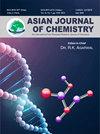磷氮系阻燃剂与硼酸锌对环氧粘土纳米复合材料热稳定性和阻燃性的影响
Q4 Chemistry
引用次数: 0
摘要
合成了一种含磷氮的 6,6'-(哌嗪-1,4-二基)双(6H-二苯并[c,e][1,2]氧膦 6-氧化物)(DOPO-PZ)阻燃剂,并研究了它与硼酸锌(ZnB)和纳米粘土(NC)结合对环氧树脂热稳定性和阻燃性的影响。使用固化剂二氨基二苯砜(DDS)制备了含有 DOPO、DOPO-PZ、ZnB 和 NC 的各种环氧树脂复合材料。复合材料的 X 射线衍射(XRD)和透射电子显微镜(TEM)显微照片显示了环氧树脂-粘土纳米复合材料的插层纳米结构。在热重分析(TGA)中,纯环氧树脂在 700 ºC 氮气环境下的产炭量为 3.4%,而含磷 1%、硼酸锌(ZnB)5 wt.% 和纳米粘土(NC)3 wt.% 的 EP/DOPO-PZ/ZnB/NC 样品的产炭量增加到 24.0%。差示扫描量热法(DSC)研究表明,添加阻燃剂后,玻璃化转变温度(Tg)因塑化效应而降低,而添加纳米粘土后,玻璃化转变温度(Tg)因环氧树脂复合材料纳米结构的形成而升高。EP/DOPO-PZ/ZnB/NC 纳米复合材料样品的极限氧指数(LOI)值为 29.2%,以 V-0 级通过了 UL-94 测试,因此具有足够的阻燃性。本文章由计算机程序翻译,如有差异,请以英文原文为准。
Effect of Phosphorus-Nitrogen based Flame-Retardant Combined with Zinc Borate on Thermal Stability and Flame Retardancy of Epoxy Clay Nanocomposites
A phosphorus-nitrogen containing 6,6'-(piperazine-1,4-diyl)bis(6H-dibenzo[c,e][1,2]oxaphosphinine 6-oxide) (DOPO-PZ) flame-retardant was synthesized and its effect combined with zinc borate (ZnB) and nanoclay (NC) on thermal stability and flame retardancy of epoxy resin was studied. Various epoxy composites containing DOPO, DOPO-PZ, ZnB and NC using curing agent diaminodiphenylsulfone (DDS) were prepared. The X-ray diffraction (XRD) and transmission electron microscope (TEM) micrographs of the composites showed intercalated nanostructure of epoxy-clay nanocomposites. In thermogravimetric analysis (TGA), pure epoxy gave 3.4% char yield at 700 ºC in nitrogen atmosphere, while in case of EP/DOPO-PZ/ZnB/NC sample having 1% phosphorus content, 5 wt.% zinc borate (ZnB) and 3 wt.% nanoclay (NC), the char yield is increased to 24.0%. Differential scanning calorimetry (DSC) study showed decrease in the glass transition temperature (Tg) on the addition of flame-retardant due to plasticization effect and increase in Tg on addition of nanoclay due to formation of nanostructure of epoxy composites. The EP/DOPO-PZ/ZnB/NC nanocomposite sample exhibited a limiting oxygen index (LOI) value of 29.2% and passed the UL-94 test with a V-0 rating and thus achieved a sufficient flame retardancy.
求助全文
通过发布文献求助,成功后即可免费获取论文全文。
去求助
来源期刊

Asian Journal of Chemistry
化学-化学综合
CiteScore
0.80
自引率
0.00%
发文量
229
审稿时长
4 months
期刊介绍:
Information not localized
 求助内容:
求助内容: 应助结果提醒方式:
应助结果提醒方式:


